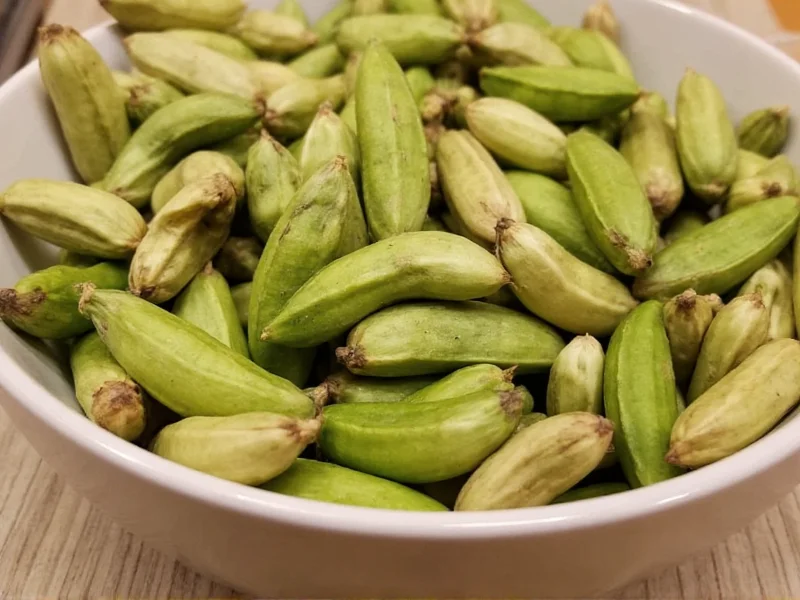Cardamom pods, the small triangular seed pods from Elettaria cardamomum plants, deliver one of the world's most prized spice experiences. Unlike pre-ground alternatives, whole pods preserve their complex flavor profile longer and offer unique culinary advantages. Understanding proper usage techniques maximizes their aromatic potential in both traditional and modern recipes.
What Makes Cardamom Pods Special
Green cardamom pods contain tiny black seeds surrounded by a thin, fibrous husk. This structure serves a purpose: the husk protects the volatile oils within the seeds, which include cineole, limonene, and terpinolene compounds responsible for cardamom's distinctive flavor. When used correctly, these pods provide a brighter, more nuanced taste than ground cardamom, which loses potency quickly.
Culinary Applications of Cardamom Pods
Chefs worldwide prize cardamom pods for their ability to enhance both sweet and savory dishes. The key to successful usage lies in understanding when to use whole pods versus crushed seeds.
Whole Pod Techniques
Adding whole pods works best in dishes with extended cooking times. In Indian biryani, pods simmer with rice, releasing flavor gradually without becoming bitter. Scandinavian cardamom buns often include a single pod in the dough for subtle infusion. For beverages like cardamom pods for tea benefits, add one pod per cup to hot water and steep for 5-7 minutes before removing.
| Dish Type | Pod Quantity | Preparation Method |
|---|---|---|
| Rice dishes (4 servings) | 3-4 pods | Add whole at beginning of cooking |
| Baked goods | 5-6 pods | Crush seeds, discard husks |
| Tea/Coffee (single serving) | 1 pod | Steep whole in hot liquid |
| Curries (4 servings) | 6-8 pods | Add whole, remove before serving |
How to Crush Cardamom Pods Properly
For applications requiring immediate flavor release like how to use cardamom pods in baking, crushing becomes necessary. Proper technique matters: gently crack pods with a knife flat or mortar pestle, then separate seeds from husks. The husks contain bitter compounds that can overpower delicate recipes. Many Scandinavian bakers use this method for kardemummabullar, ensuring even distribution of flavor without fibrous bits.
Traditional Uses Beyond Cooking
Across various cultures, cardamom pods have served purposes beyond flavoring food. In Middle Eastern traditions, people chew whole pods to freshen breath after meals—a practice supported by cardamom's antimicrobial properties. Ayurvedic practitioners have historically used cardamom pods in cardamom pods health benefits preparations for digestive support, though modern science hasn't confirmed these effects. Some cultures incorporate crushed pods into natural cleaning solutions for their pleasant scent and mild antibacterial qualities.
Storage Techniques for Maximum Freshness
Proper storage significantly extends cardamom pods' shelf life. Keep them in an airtight container away from light and heat. Whole pods maintain potency for 6-12 months under these conditions, compared to just 3-6 months for ground cardamom. For extended storage, freeze pods in a sealed bag—this preserves volatile oils better than room temperature storage. Always check for aroma before use; faded scent indicates diminished quality.
Cardamom Pods in Global Cuisines
Different culinary traditions showcase unique approaches to cardamom pods in Indian cooking versus other regional applications. Indian cuisine often combines cardamom with cloves and cinnamon in garam masala, while Arabic coffee preparation involves crushing pods directly into brewing coffee. In Nordic countries, bakers incorporate finely ground cardamom into dough for characteristic flavor in pastries. Understanding these cultural contexts helps home cooks apply cardamom authentically.
Common Usage Mistakes to Avoid
Many home cooks make critical errors when working with cardamom pods. Adding whole pods to quick breads creates unpleasant texture. Over-toasting seeds before grinding produces bitter notes. Using expired pods yields weak flavor that fails to justify cardamom's premium price. For optimal results in cardamom pods in middle eastern cuisine applications, always use fresh pods and adjust quantities based on dish requirements rather than blindly following recipes.
Frequently Asked Questions
Can I substitute ground cardamom for whole pods?
Yes, but with adjustments. Use 1/4 teaspoon ground cardamom per pod, added later in cooking since ground spice loses flavor faster. Whole pods provide more complex flavor in slow-cooked dishes.
How do I remove cardamom husks efficiently?
Place pods on a cutting board and gently press with the flat side of a knife until they crack. Separate seeds from husks using your fingers or a small spoon. Discard fibrous husks which can impart bitterness.
Are black cardamom pods used differently than green ones?
Yes. Black cardamom has a smokier flavor profile and is typically used in savory Indian dishes like rogan josh, while green cardamom works better in sweets and beverages. They're not interchangeable in most recipes.
Can I grow cardamom plants from store-bought pods?
Rarely. Commercially sold pods are usually heat-treated to prevent sprouting. True cardamom cultivation requires specific tropical conditions and takes 2-3 years before producing harvestable pods.
Why do some recipes specify removing cardamom pods after cooking?
Prolonged cooking makes pods increasingly bitter. Removing them after infusing flavor prevents undesirable notes. This technique is essential for delicate dishes like rice pudding or light sauces.











 浙公网安备
33010002000092号
浙公网安备
33010002000092号 浙B2-20120091-4
浙B2-20120091-4